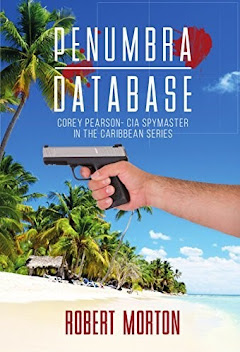 |
| Modern CIA Operatives Evade High-Tech Detection |
In today’s world, trying to go undercover is like trying to disappear in a house of mirrors. Facial recognition, biometric passports, AI-driven surveillance, heat mapping, digital footprints—everywhere you go, something’s watching, tracking, logging. But believe it or not, the CIA still knows how to make people vanish. And operatives like Corey Pearson—fictional spymaster from the novel Shadow Wars—mirror the real-life techniques America’s spies use to stay invisible in a world that sees everything.
Take this scene from Shadow Wars:
CIA officer Corey Pearson is flying under the radar—both figuratively and
literally. He’s not just skipping airports to avoid the hassle; he’s steering
clear of the entire global surveillance network. His previous fake identity?
Compromised. Why? Because biometric data—like fingerprints, facial recognition,
and iris scans—is now stored and shared across international border control
systems. If just one of those scans doesn’t match up with his new alias, the
system will flag it instantly. That iris scan from a mission three years ago?
Still stored in some database. One trip through a commercial airport, and the
entire mission could be exposed.
So instead, Corey skips the airport circus
and boards a CIA-owned Beechcraft, flown by a pilot who technically works for a
fake airline that isn’t even listed anywhere. No TSA, no cameras, no biometric
scans—just cruising at 20,000 feet with classified intel in his lap and a
Vesper martini in his hand. Yeah, he actually mixes it himself mid-flight, like
it’s happy hour at Langley.
Sounds like fiction? It is. But it's not
far from the truth. In the Cold War, disguises and dead drops got the job done.
Today? Spies have to dodge a digital dragnet.
Biometric passports are now standard
across most of the developed world. They log facial geometry, fingerprints,
iris patterns—and link those to flight manifests, hotel check-ins, and even
Wi-Fi connections. In 2017, China reportedly used facial recognition and AI to
identify and dismantle a network of CIA informants, leading to a major roll-up
of American assets in the region. Some were imprisoned. Others were
executed—shot in courtyards as a warning to others. It wasn’t bad tradecraft—it
was tech outpacing traditional espionage.
To beat the system, the CIA uses advanced
tactics: covert flights on agency-owned planes hidden behind shell companies;
synthetic identities with full digital backstories—fake social media, public
records, and credit histories; burner biometrics like prosthetics or disruptors
to trick facial recognition; and geofencing avoidance with GPS tools and EMF
shielding to slip past zones that track phones or faces.
Operatives are trained to move like
shadows. They're taught to blend in, leave no pattern, and think like
algorithms—constantly asking: What would the system expect me to do next?
Then do the opposite.
In Shadow Wars, CIA
pilot Mark flies for an airline called “High-Speed Transport Airlines”—a
company with no website, no real headquarters, and no obvious connection to the
federal government. His paycheck shows up like clockwork. He just doesn’t ask
too many questions.
This mirrors real programs. The CIA has
long operated covert airlines. Back in the Cold War, it was Air America. In the
War on Terror, it was companies like Aero Contractors and Tepper Aviation.
These are not relics—they’ve just evolved. Shell companies with blank websites.
Planes that file vague flight plans. Crews that don’t know the mission—or don’t
want to.
Even the “service cart” scene, where Corey
mixes martinis in midair, sounds cinematic—but it illustrates a core truth:
espionage is a world where even the mundane is curated for control. A drink
might be just a drink, or it might be a distraction, a bonding ritual, or a
coded signal.
Shadow Wars taps
into a critical tension: in a high-tech world, old-school spycraft isn’t
obsolete—it’s just harder.
When Corey studies the file on the
“Invisible Killer,” a Russian operative who mastered deception in Cold War
Berlin, he’s not just dealing with ghosts of the past. He’s facing a new breed
of enemy: one who understands both old methods and new tools. In real life,
adversaries like Russia and China have combined classic HUMINT (human
intelligence) with cutting-edge SIGINT (signals intelligence) to devastating
effect.
Today’s operatives must master both.
They’re trained to disappear not just from sight, but from the grid. That means
flying under fake flags, living under deep-cover identities, and using
tradecraft that blends psychological manipulation with digital hygiene.
In an era when your face is your passport
and your phone is a tracking device, it might seem like the age of espionage is
over. But it's not. It’s just evolved. The CIA isn't sending people into the
field blindly. They're sending ghosts—operatives trained to hack the
surveillance state, navigate a world of constant tracking, and operate in plain
sight.
What Shadow Wars shows
us is that the spy game hasn’t died—it’s just gotten smarter. And for guys like
Corey Pearson, secrecy isn’t just a tactic. It’s survival.
Robert Morton is a member of the Association of Former Intelligence Officers (AFIO) and writes about the U.S. Intelligence Community (IC). He also writes the Corey Pearson- CIA Spymaster Series, which blends his knowledge of real-life intelligence operations with gripping fictional storytelling. His work offers readers an insider’s glimpse into the world of espionage, inspired by the complexities and high-stakes realities of the intelligence community.






No comments:
Post a Comment